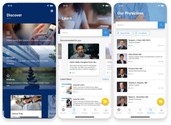Healthcare Mobile App Development
We Build Custom iOS, WatchOS, & Android Apps for Healthcare Organizations
A custom mobile app can help your organization encourage better patient outcomes, improve communication, offer greater convenience for patients, and simplify your internal workflows.
We’re committed to the success of your project, and it shows in everything we create. We specialize in designing and developing custom healthcare apps for companies ranging from startups to medium- and large-sized healthcare enterprises.
Who We Build Healthcare Mobile Apps For
We’re Experts in Custom Medical Mobile App Development
Our custom health app developers use the latest healthcare software development technologies to create innovative, custom solutions to our clients’ most difficult challenges. We understand the unique needs and challenges that healthcare organizations face, and we offer solutions that address pain points and help your organization meet its goals.
We work with each client to provide a solution that’s strategically aligned at all levels of the organization. This means improved usability, as well as improved availability of data across the broader organizational health IT ecosystem.
See Our work
Baylor Heart and Vascular Center
Baylor’s award-winning app provides educational resources for patients like videos, podcasts, and blog content, as well as guided meditations and useful features like navigation. The app also integrates with Apple Watch in order to provide heart rate data.
See more of our WorkMobile vs. Web Apps: Why Build a Mobile App?
A mobile medical app offers a number of benefits over a healthcare web application (which is accessed via the user’s browser, and does not require the user to download the app).
Medical Mobile Apps with Rich Features and Functionality
As an industry-leading healthcare app development company, Medical Web Experts has extensive experience in custom, HIPAA-compliant healthcare app development. Our medical app developers build apps with features and functionality that address your organization’s key needs.
- Bill pay
- Rx refill requests
- Physician search
- Location search
- Urgent care wait times
- Telehealth solutions
- Integration with wearable devices, including Apple Watch
- Secure messaging
- Appointment scheduling
- Patient notifications/reminders
- Navigation solutions
- CCDA-based health summaries
- Lab results
- Symptom checker
- News and events
- Video library
Integrate with Your Existing Systems
We build custom interfaces and integrations that allow your app to integrate seamlessly with the systems your organization is already using.
- Electronic health record (EHR) or electronic medical record (EMR) software
- Revenue cycle management (RCM) software
- Practice management (PM) systems
- Laboratory information system (LIS) or lab information management systems (LIMS)
- Radiology information system (RIS)
- Pharmacy information system (PIS)
- Health Information Exchange (HIE)
- Pharmacy benefit manager software
- Patient portals
- Patient scheduling software
- Customer relationship management (CRM) software
- Custom databases
We Have Health App Development Down to a Science
With experience in medical app development dating back to 2003, we know what it takes to make your project successful. Our deep experience allows us to work with clients in any of the following project stages:
Goals
Knowing what business objectives a project aligns with and how the success and value of a custom health application will be measured is vital to creating a high-value solution.Discovery
Outlining a clear set of features and functionalities aligns our team with yours and places a set direction and scope on project implementation.Planning
Establishing a roadmap and order in the design, development, testing and deployment allows clear milestones to be defined and checkpoints to be established between our team and yours.Design
Ensuring ease of access to and usability of features and functionalities increases the effectiveness of any custom health application.Development
Our health app developers bring your custom health application concept to life.Testing
First impressions are everything. Testing allows you to make a quality first impression with your application’s end users.Deployment
Now that your application has gone from concept to reality, it’s time to start using it.Tracking, measuring and analyzing usage helps your organization increase the overall value of its health application. Choosing a long-term software development partner allows you to iteratively improve and enhance the functionality and performance of your custom medical app.
